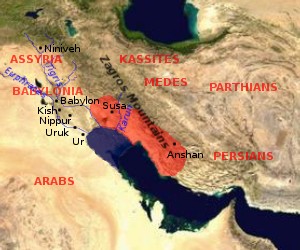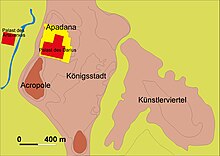സൂസ
| شوش (in Persian) | |
 Tepe of the Royal city (left) and of the Acropolis (right), seen from the Hill mound of the Apadana in Susa. | |
| സ്ഥാനം | Shush, Khuzestan Province, Iran |
|---|---|
| മേഖല | Zagros Mountains |
| Coordinates | 32°11′26″N 48°15′28″E / 32.19056°N 48.25778°E |
| തരം | Settlement |
| History | |
| സ്ഥാപിതം | Approximately 4200 BCE |
| ഉപേക്ഷിക്കപ്പെട്ടത് | 1218 CE |
| Site notes | |
| Condition | In ruins |
| Official name | Susa |
| Type | Cultural |
| Criteria | i, ii, iii, iv |
| Designated | 2015 (39th session) |
| Reference no. | 1455 |
| State party | Iran |
| Region | Asia-Pacific |
Part of a series on the |
|---|
| Iran പ്രദേശത്തിന്റെ ചരിത്രം |
 |
ഇറാനിലെ പാർഥിയ സാമ്രാജ്യത്തിന്റെയും,സെലിയൂസിഡ്, ആദ്യ പേർഷ്യൻ സാമ്രാജ്യം, ഇലമിറ്റെ എന്നിവിടങ്ങളിലെ പുരാതന നഗരമാണ് സൂസ (/ˈsuːsə/; പേർഷ്യൻ: شوشഷൂഷ്[ʃuʃ]; Hebrew שׁוּשָׁן,ഷൂഷാൻ Σοῦσα [ˈsuːsa]; സുറിയാനി: ܫܘܫ, ഷുഷ് .പുരാതന നിയർ ഈസ്റ്റിലെ ഏറ്റവും പ്രധാനപ്പെട്ട നഗരങ്ങളിൽ ഒന്നാണ് ഇത്.സാഗ്രോസ് മലനിരകൾക്ക് താഴെ സ്ഥിതി ചെയ്യുന്നത്.ടൈഗ്രീസ് നദിക്ക് 250കിലോ മീറ്റർ കിഴക്കും കർഖേഹ് ഡെസ് നദികൾക്ക് മധ്യത്തിലുമാണ് ഇത് സ്ഥിതി ചെയ്യുന്നത്.2015ൽ ഇവിടം യുനെസ്ക്കോ പൈതൃക കേന്ദ്രമായി തിരഞ്ഞെടുത്തു.
ആധുനിക ഇറാനിയൻ പട്ടണമായ ഷൂഷ് സ്ഥിതി ചെയ്യുന്നത് പുരാതന സൂസ പ്രദേശത്താണ്.ഇറനിലെ ഖുസെസ്താൻ പ്രവിശ്യയിലെ ഷൂഷ് രാജ്യത്തിന്റെ ഭരണ തൽസ്ഥാനമാണ് ഷൂഷ്.2005ൽ ഇവിടത്തെ ജനസംഖ്യ 64,960 ആയിരുന്നു[1] .
ചരിത്രം
[തിരുത്തുക]
പുരാതന നിയർ ഈസ്റ്റിലെ ഏറ്റവും പ്രധാനപ്പെട്ട നഗരങ്ങളിൽ ഒന്നാണ് സൂസ. ചരിത്ര രചനകളിൽ വളരെ പുരാതന സുമേറിയൻ രേഖകളിൽ സൂസ പരാമർശിക്കപ്പെടുന്നു. എന്മെർക്കർ ആൻഡ് ദ ലോഡ് ഓഫ് അറാറ്റ(Enmerkar and the Lord of Aratta) ഇതിന് ഒരു ഉദാഹരണമാണ്.ഹീബ്രൂ ബൈബിളിൽ സൂസയെ ഷൂഷാൻ എന്ന് പരാമർശിക്കുന്നു.നെഹെമിയൻ(Nehemiah) ,ഡാനിയൽ എന്നിവയിൽ ഓരോ തവണയും ഈ പ്രദേശത്തെ പരാമർശിക്കുന്നു.ധാരാളം പണ്ഡിതന്മാർ സ്റ്റാർ ഓഫ് ഡേവിഡിന്റെ ഒരു സ്ഥാനമായി പരിഗണിക്കുന്നു.ബുക്ക് ഓഫ് ജൂബിലീസിലും സൂസയെ പരാമർശിക്കുന്നു.
ആർക്കിയോളജി
[തിരുത്തുക]

1836ൽ ഹെന്രി റവ്ലിൻസണും 1851ൽ എ.എച്ച്..ലയർഡും ഈ സ്ഥലത്തെ പറ്റി വിശദമായി പഠിച്ചു[2].വില്യം ലോഫ്റ്റുസ് മികച്ച രീതിയിൽ ഖനനം നടത്തുകയും ഈ സ്ഥലം സൂസയാണെന്ന് തിരിച്ചറിയുകയും ചെയ്തു[3].
ജാക്ക്വസ് ഡി മോർഗൻ 1897 മുതൽ 1911 വരെ ഇവിടെ വലിയ രീതിയിൽ ഖനം നടത്തി.ഇതിന്റെ തുടർച്ചയായി റൊണാൾഡ് ഡി മെക്ക്വെനെം 1914 ഒന്നാം ലോക യുദ്ധ കാലം വരെ പഠനങ്ങൾ നടത്തി.മെക്ക്വെനെമിന്റെ നേതൃത്വത്തിൽ ഫ്രഞ്ച് യുദ്ധത്തിനു ശേഷം പ്രവർത്തനങ്ങൾ തുടരുകയു രണ്ടാം ലോകയുദ്ധ കാലം വരെ നീണ്ട് നിൽക്കുകയും ചെയ്തു[4] [5][6] .1946 മുതൽ റോമൻ ഘ്രിഷ്മന്റെ നേതൃത്വത്തിൽ ഖനനം പുനരാരംഭിച്ചു.1970കളിൽ ജീൻ പെരറ്റിന്റെ നേതൃത്വത്തിൽ ഖനനം തുടർന്നു[7][8].
അവലംബം
[തിരുത്തുക]- ↑ "World city populations: Susa". Mongabay.com. 2008-12-02. Retrieved 2013-02-08.
- ↑ George Rawlinson, A memoir of Major-General Sir Henry Creswicke Rawlinson, Nabu Press, 2010, ISBN 1-178-20631-9
- ↑ Google Books, William K. Loftus, Travels and Researches in Chaldaea and Susiana, Travels and Researches in Chaldaea and Susiana: With an Account of Excavations at Warka, the "Erech" of Nimrod, and Shush, "Shushan the Palace" of Esther, in 1849-52, Robert Carter & Brothers, 1857
- ↑ Archive.org, Jacques de Morgan, Fouilles à Suse en 1897–1898 et 1898–1899, Mission archéologique en Iran, Mémoires I, 1990
- ↑ Archive.org, Jacques de Morgan, Fouilles à Suse en 1899–1902, Mission archéologique en Iran, Mémoires VII, 1905
- ↑ Robert H. Dyson, Early Work on the Acropolis at Susa. The Beginning of Prehistory in Iraq and Iran, Expedition, vol. 10, no. 4, pp. 21-34, 1968
- ↑ Jean Perrot, Les fouilles de Sus en 1975, Annual Symposium on Archaeological Research in Iran 4, pp. 224-231, 1975
- ↑ D. Canal, La haute terrase de l'Acropole de Suse, Paleorient, vol. 4, pp. 169-176, 1978
പുറത്തെക്കുള്ള കണ്ണികൾ
[തിരുത്തുക]- Susa Archived 2011-07-25 at the Wayback Machine
- Livius.org pictures of Susa Archived 2018-12-25 at the Wayback Machine
- Aerial views of Susa Archived 2006-05-03 at the Wayback Machine
- Susa City Home Page Archived 2016-09-05 at the Wayback Machine
- Digital Images of Cuneiform Tablets from Susa - CDLI Archived 2011-06-17 at the Wayback Machine
- Hamid-Reza Hosseini, Shush at the foot of Louvre (Shush dar dāman-e Louvre), in Persian, Jadid Online, 10 March 2009.
- Audio slideshow at Jadidonline.com (6 min 31 sec)
 "സൂസ". The New Student's Reference Work. Chicago: F. E. Compton and Co. 1914.
"സൂസ". The New Student's Reference Work. Chicago: F. E. Compton and Co. 1914.
- Pages using gadget WikiMiniAtlas
- Pages using the JsonConfig extension
- Articles with Persian-language sources (fa)
- Portal-inline template with redlinked portals
- Pages with empty portal template
- Multilingual support templates
- Pages with plain IPA
- Articles containing Syriac-language text
- Commons link is locally defined
- ഇറാനിലെ നഗരങ്ങൾ
- യുനെസ്കോ ലോകപൈതൃകസ്ഥാനങ്ങൾ



